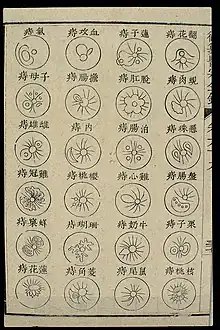Yuzuan yizong jinjian

The Yuzuan yizong jinjian (Chinese: 御纂醫宗金鑑; pinyin: Yùzuǎn yīzōng jīnjiàn)[lower-alpha 1] is a Chinese medical compendium published in 1742 AD, during the Qing dynasty. Described as "one of the best treatises on general medicine of modern times", it was a project sanctioned by the Qianlong Emperor and published by the Imperial Printing Office.
Contents
The text is divided into ninety juan or volumes: seventy-four volumes pertain to internal medicine, while the remaining sixteen concern general surgery.[4] More than a quarter of the text reproduces, with added commentary, two parts of an earlier work written by Zhang Zhongjing, the Shanghan zabing lun (Treatise on Cold Damage and Miscellaneous Disorders);[5] Zhang's work is presented by the authors of the Yuzuan yizong jinjian as foundational to Chinese medical orthodoxy.[6]
It also contains what is "probably the largest ensemble of illustrations in a single Chinese medical text", with some 484 such depictions of the human body, ranging from images of children's hands to a "one-page array of 24 anuses".[7] Depictions of smallpox—a disease that was especially deadly to the ruling Manchurians—are particularly prominent and detailed.[8]
Publication history
An initiative of the Qianlong Emperor that was announced on 17 December 1739,[9] the Yuzuan yizong jinjian was published in 1742 by the Imperial Printing Office,[2] which designated it as a national textbook.[10] The text had some eighty contributors, including thirty-nine members of the Imperial Academy of Medicine,[2] most of whom came from the Jiangnan region,[3] specifically the southern provinces of Anhui, Jiangsu, and Zhejiang.[11] Imperial Physicians[lower-alpha 2] Wu Qian (吳謙) and Liu Yuduo (劉裕鐸) served as editors-in-chief,[12] under the supervision of Manchu official Ortai.[4]
Legacy
The Yuzuan yizong jinjian has been noted for "its breadth, editorial accuracy, medical coverage, and use of mnemonic rhymes".[13] Moreover, it has "attained the status of a canonical medical classic which, even today, remains obligatory reading for scholars and practitioners of traditional Chinese medicine."[14] K. Chimin Wong and Liande Wu, writing in the History of Chinese Medicine (1973), describe the text as "one of the best treatises on general medicine of modern times."[15]
Notes
- ↑ Various English translations include the Imperially Sponsored Golden Mirror of Medical Orthodoxy,[1] the Imperially Commissioned Golden Mirror of the Orthodox Lineage of Medicine,[2] or the Commissioned Golden Mirror of Medical Learning.[3] It is also simply referred to as the Golden Mirror.[2]
- ↑ Imperial Physician was the highest rank that a physician at the Imperial Academy of Medicine could have obtained.[12]
References
Citations
- ↑ Smith 2015, p. 363.
- 1 2 3 4 Yang 2021, p. 904.
- 1 2 Wu 2018, p. 111.
- 1 2 Torck 2009, p. 59.
- ↑ Hanson 2003, p. 133.
- ↑ Wu 2013, p. 177.
- ↑ Wu 2018, p. 112.
- ↑ Wu 2018, pp. 116–117.
- ↑ Hanson 2003, p. 117.
- ↑ Unschuld & Zheng 2014, p. 4.
- ↑ Hanson 2003, p. 116.
- 1 2 Hanson 2003, p. 127.
- ↑ Hanson 2003, p. 132.
- ↑ Torck 2009, p. 61.
- ↑ Wong & Wu 1973, p. 172.
Bibliography
- Hanson, Marta (2003). "The Golden Mirror in the imperial court of the Qianlong emperor, 1739–1742". Early Science and Medicine. 8 (2): 111–147. doi:10.1163/157338203x00035. PMID 15043047.
- Smith, Richard J. (2015). The Qing Dynasty and Traditional Chinese Culture. Rowman & Littlefield Publishers. ISBN 9781442221949.
- Torck, Mathieu (2009). Avoiding the Dire Straits: An Inquiry Into Food Provisions and Scurvy in the Maritime and Military History of China and Wider East Asia. Harrassowitz. ISBN 9783447058728.
- Unschuld, Paul; Zheng, Jinsheng (2014). Chinese Traditional Healing. Vol. 1. Brill. doi:10.1163/9789004229099. ISBN 9789004229099.
- Wong, K. Chimin; Wu, Liande (1973). History of Chinese Medicine: Being a Chronicle of Medical Happenings in China from Ancient Times to the Present Period (2nd ed.). AMS Press. ISBN 9780404079901.
- Wu, Yi-Li (2013). "The Qing Period". In TJ Hinrichs; Linda L. Barnes (eds.). Chinese Medicine and Healing: An Illustrated History. Harvard University Press. pp. 161–208. doi:10.2307/j.ctv15pjz2g.9.
- Wu, Yi-Li (2018). "The Gendered Medical Iconography of the Golden Mirror, Yuzuan Yizong Jinjian 御纂醫宗金鑑, 1742". In Vivienne Lo (ed.). Imagining Chinese Medicine. Vol. 18. Brill. pp. 111–132. doi:10.1163/9789004366183_008. JSTOR 10.1163/j.ctvbqs6ph.12.
- Yang, Jessica S. (2021). "Medical illustration in China: The Golden Mirror, an 18th-century imperial court medical text". Clinics in Dermatology. 39 (5): 904–906. doi:10.1016/j.clindermatol.2020.11.009. PMID 34785020. S2CID 229405971.